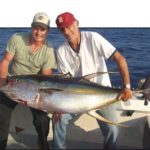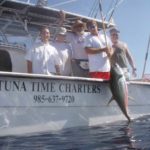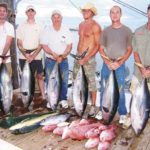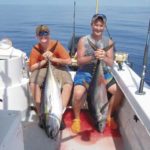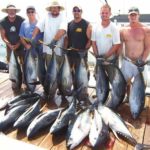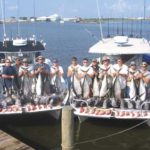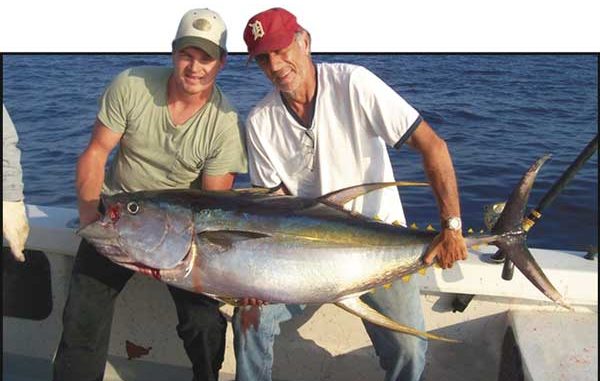
Sit down in your desk and heed the advice of these yellowfin experts.
Do you believe the economy is bad just because somebody on TV tells you it is? Or do you find yourself financially flourishing when you are supposed to be suffering? I’ll bet there aren’t too many “sheeple” among the hunters and anglers of Louisiana who let others decide their own fates.
The independently thinking among us would never purposefully break off a fish just because somebody else told us they weren’t biting. And we’re not going to go broke just because somebody else told us the economy is bad.
If you know where to invest your time and money, whether it’s fishing or the stock market, you can be successful while everybody else struggles. But in today’s economy, which is showing signs of inflation, knowing where to put our time and money is becoming even more important if we are to continue to succeed. Financial investments must yield returns.
Fishing investments must yield returns, too. It’s getting harder and harder to justify to momma why we’re spending $3.50 per gallon on gasoline when we come home with no meat for the table. And the only way we’re going to consistently put meat on the table is if we know where to put our time and money.
No arena of angling requires more of both those things than offshore fishing. But offshore fishing is like grabbing for the proverbial brass ring. Everybody along the Gulf of Mexico knows what’s there. So often, though, it seems like it’s just out of reach.
That’s why if you’re heading offshore this summer to try the tuna, you better make sure you get the best return you can on your investment. And that’s exactly what offshore fishing is turning into — an investment. To get that return, you’ve got to know where to put your time and money.
Two offshore captains who excel at helping their customers get that return are Ed Frekey with Tuna Time Charters and Richard Daughdrill with Cherece IV Charters.
Both captains have already made much of the investment for their customers, and investing in their time and experience will help those returns come in quicker. Their years on the water have taught them where to go and what to throw, and their on-the-water lessons are priceless.
On the other hand, if you’ve got your own boat and are ready to fill your tanks, they can still help you out by offering some advice on how to manage your time on the water. Consider them, if you will, your own personal tuna teachers.
“Anybody can buy a boat that runs two-screw or three-screw outboards,” said Frekey. “As long as you have 300 gallons of fuel, you can go make the trips way offshore during the summer. Just making the trip isn’t the difference maker, though. It’s knowing what to do when you get 70 to 90 miles out that makes the difference.”
The difference comes when offshore anglers hit what Frekey called the “ah-ha” moment. This is when everything anglers have read about tuna techniques and principles suddenly makes sense on the water. Until you see it come to life on the water, tuna fishing often is nothing more than a misguided search for the easy way.
Consistently catching tuna during June isn’t easy, though. It may seem easy if you see them slashing into bait as soon as you first pull up to a rig, and it may be for a while, or even a day or two. But how you respond when they go down or they change their diet is what separates the tuna teachers from the tuna students.
“I’ve had trips where I know I’m doing everything right but we still don’t catch fish,” Frekey admitted. “It might be that they’ve shut down after feeding. It might be you’re throwing what you think is the perfect bait before you cut their stomachs to see they’re feeding on baby sardines or baby this and that — if you can’t match what they’re eating, you don’t have a shot in hell.”
The first thing Frekey and Daughdrill do during June is to make considerable runs to the floaters that are deeper than 1,000 feet. Frekey has noticed that the fish seem to be staying more and more out there than they do in closer. As recently as this past February, he had a wonderful trip to the floaters while everybody was still struggling on the Lump.
“It could have been a fluke,” he conceded, “but we made an overnight trip and did really well. My theory is that they are on the floaters a lot more than what we think. Why they move in sometimes is anybody’s guess. Everybody has his or her own theories — trawl boats, mullet, bait at the mouth of the river. I can’t say because I’m not a tuna. But I do know that summer trips, whether they’re during the day or night, are floater runs.”
According to both guides, the absolute best tuna trip during the summer is a night trip. The fish can be caught during day trips, but the numerous advantages of the night trips so far outweigh those of the day trips that each recommended night trips for anglers who are dead set on catching tuna, especially yellowfin.
“The big advantage of night versus day is that the angler immediately eliminates one of the tuna’s best advantages, its eyesight,” said Daughdrill. “At night, you can use heavier leader and bigger hooks. You can use 100-pound fluorocarbon, and you don’t have to hide tiny hooks in the bait. All this makes your hook to catch ratio a lot better than it is during the day.”
Another reason Frekey and Daughdrill recommend the night trips is because they simply allow anglers to spend more time with baits in the water during the three most consistent tuna bites of a 24-hour period — evening right at dark, midnight and daybreak. While anglers could conceivably be at a floater at daybreak on a day trip, they would have to leave by about 2 a.m. to get there on time.
“I tell everybody who calls that we can guarantee a yellowfin on a night trip,” Frekey said. “Nobody is going to make that claim during the day. Some people claim you don’t have to go at night, but if you go on 20 day trips and I make 10 night trips, I guarantee you I’ll catch more.”
According to Daughdrill, the best it can get during the summer for tuna fishing is to get to a floater right before dark and to fish the same rig all night. He’ll move around if necessary and feasible, but he makes sure to be on a floater again at daybreak.
“That first daylight bite is usually the best you’re going to get,” he said. “It’s not a guarantee, but tuna typically feed best right when the sun is just breaking. This time period offers some of the most action of the entire 24-hour period.”
Like Frekey mentioned, though, just getting to a floater isn’t good enough. He goes through a step-by-step process to make sure he’s on the right floater, and he frequently relies on a network of fishing friends who share information if needed.
“The first thing I do as I approach a floater is find the current,” said Frekey. “At the same time, I’m looking to see if fish are busting or rolling. That’s the kind of sign that let’s me know immediately that I’m on the right floater.”
Any activity upon pulling up to the floater means Frekey will start putting out some live bait. If he sees flying fish in the mix, he knows to cast poppers or flying-fish lures. He’ll stay with the active fish until they go down.
If Frekey doesn’t see actively feeding fish, he turns to his graph to see if he can mark them on it. He keeps his graph set at 300 feet, and that’s the depth zone that he scans for big red blobs that could be tuna, rainbow runners, bait or a combination of all three. In this case, he gets to work chumming to see if he can get them to come up and hit the chum.
“I usually mark them down around 100 or 150 feet,” he said. “When you see them holding down that deep, chumming can draw them up and turn them on. Put a bait down about 50 feet, and you can get them. If you don’t have what they’re eating, though, you’re going to get creative.”
The most important thing to remember about working the tuna on the floaters during June is that they are going to go down and come back up. Daughdrill said that tuna actually heat up with the activity of feeding. When they get too hot, they sound and go down to cool off. After that, they’ll come back to the surface to feed.
“Most of the time they’ll come back up in the same spot,” said Daughdrill. “If you’re there in the same spot when they come back up, you can catch them. Running around to chase them is a big mistake.”
Frekey agreed that chasing tuna was a bad idea because it could eventually disrupt the fish to the point that they don’t come back up. His experience has led him to believe that if you chase the tuna, they are going to come up 20 yards too far every time.
“We all want to run over there and get our baits in the water,” he said. “We see them come up and we move over to them then they go down. They come back up 20 yards too far, and we hurry up to get over there again. If you do that, you’re going to spend all day running back and forth.
“If you’re in the right zone where you marked fish earlier on your graph, the better thing to do is try to hold in that area and move slowly with maybe one engine. It’s hard not to run up to them when you see them busting, but you learn quickly that it doesn’t work.”
One of the things that presents such a challenge to charter captains and recreational anglers alike is why certain rigs hold fish while others don’t. The answer according to Frekey and Daughdrill is simple — bait.
“If we’re in an area where there are three or four rigs close by in the same general location we’ll go to another one if the first isn’t producing,” Daughdrill said. “Sometimes we find fish on one and not the others. Sometimes it’s an area thing where none of the rigs in the same location hold tuna. It all depends on what they want to eat and the location of what they want to eat.”
Frekey staunchly believes anglers can find productive rigs quicker if they build a network of other anglers who fish just like them. In other words, if you’re a rig fisherman, use today’s technology to find other rig fishermen. If you fish wrecks, find other wreck fisherman. It’s easy enough with the Internet to find 10 or 15 anglers who will all be out on the same day. Honestly sharing information can lead to more caches for all.
“The thing about these tuna is that one boat can get one fish on a rig that another boat pulls in on and catches seven or eight,” Frekey said. “Once you time the bite, you can stay on them pretty good, but then everything will change on you. I would say the day-to-day patterns are more important to master than a daily change. When you really get tuned into the timing, once the bite shuts off, you may be able to say that’s your bite. It’s time to go do something else.”
Without a doubt, the best way to learn more about tuna is to spend time fishing with those who do. Wise investors know that putting their cash in the hands of seasoned money managers will lead to bigger and better things.
Likewise, if you want your fishing trips to lead to bigger and better things, you should put your time in with more experienced anglers like the tuna teachers. And just like elementary school, Momma will be mighty happy if you make the grade.
Contact Capt. Ed Frekey with Tuna Time Charters at 985-637-9720 or 985-665-3769 and Capt. Richard Daughdrill with Cherece IV Charters at 985-515-3697 or 504-452-2874.
